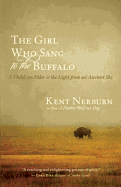
Kent Nerburn's The Girl Who Sang to the Buffalo rounds out a trilogy that began with Neither Wolf nor Dog and The Wolf at Twilight. This time, Nerburn finds himself waking repeatedly from a relentless dream in which the Ojibwe elder who had helped him track down the young sister of a now-elderly Lakota man reappears, pointing Nerburn to the ghost of the young girl, an ominous brick building and a field of dark, looming shapes he cannot quite make out.
In an effort to rid himself of the dream, Nerburn heads to northern Minnesota to speak to the Ojibwe woman Mary. At first, he writes off the dream as simply a psychological manifestation of his guilt at failing to share with Mary the information he had uncovered with her help. As events unfold, however, the author realizes that the dream is much bigger than his guilt--and, in fact, much bigger than himself.
Part memoir and part novel, The Girl Who Sang to the Buffalo introduces hints of the Lakota and Ojibwe "old ways" in a manner that reveals extraordinary insights into the human heart without betraying their source. While Nerburn's forays as a visitor to Indian cultures aren't without missteps--some of which are recorded in the tale itself--he approaches his source and its people with great respect. The result is a deeply human tale about conquering fear and the revelation that the deepest truths are often found in the smallest, quietest places among us. --Dani Alexis Ryskamp, blogger at The Book Cricket

